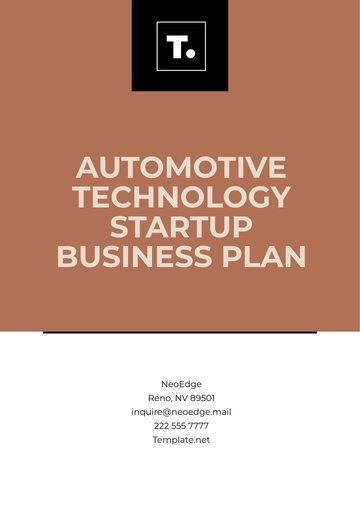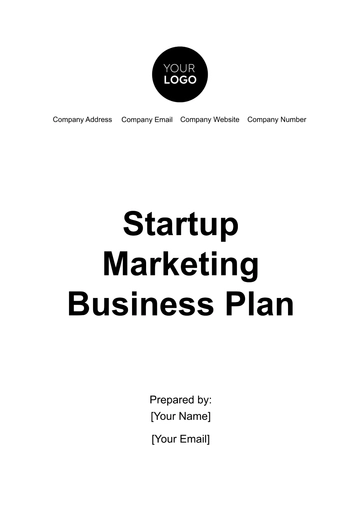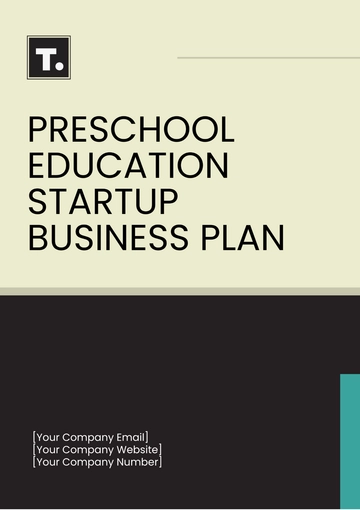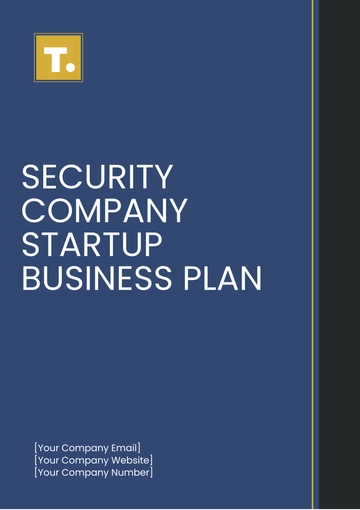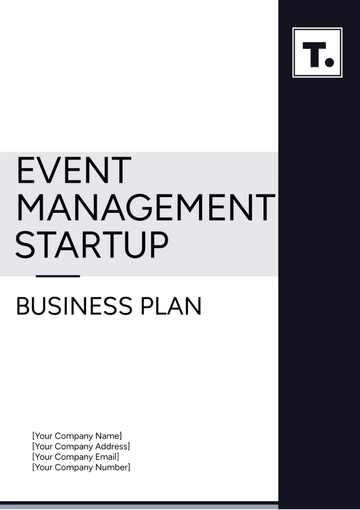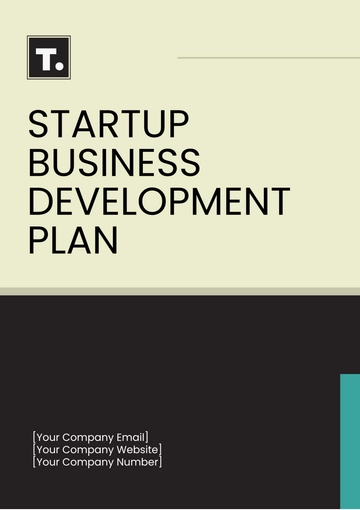Free Startup Marketing Business Plan

I. Executive Summary
This Startup Marketing Business Plan of [Your Company Name] details the strategies and tactics necessary to launch and promote our new product portfolio in a highly competitive market. With a total budget of $500,000 allocated to this launch, we aim to achieve a 150% return on investment within the first fiscal year. Our target market includes young professionals aged 25-34, tech-savvy millennials, and small-to-medium-sized enterprises (SMEs). The products are positioned to deliver superior value and innovative features that set them apart from competitors.
Our primary objective is to capture a 15% market share within 18 months, which equates to projected revenues of $2,000,000. This will be achieved through a combination of strategic pricing, targeted marketing campaigns, and a focus on building strong brand loyalty. The initial marketing efforts will concentrate on digital channels, with a significant portion of the budget allocated to social media, influencer partnerships, and content marketing.
To ensure a successful launch, we will execute our strategy in phases, beginning with a pre-launch awareness campaign, followed by a launch event, and sustained post-launch promotional activities. We expect to generate significant buzz around our products, driving both short-term sales and long-term brand equity. The integration of innovative features and competitive pricing will be crucial in differentiating our products from those of key competitors such as Bright Tech, Urban Trend, and Digital Wave.
II. Product and Pricing
The following table outlines the products in the launch, their pricing strategies, and expected market positioning. The pricing strategy is designed to appeal to our target audience while maximizing profitability.
No. | Product Name | Features | Price |
|---|---|---|---|
1 | Smart Connect | Advanced Connectivity, AI Features | $299 |
2 | Vision Hub | 360-degree Camera, Smart Alerts | $499 |
3 | Eco Charge | Fast Charging, Energy Efficient | $149 |
A. Smart Connect
Advanced Connectivity: Smart Connect is designed to offer seamless connectivity across multiple devices. This feature appeals to tech-savvy consumers who require efficient and reliable technology for their daily tasks.
AI Features: The product integrates artificial intelligence to enhance user experience. The AI-driven features provide personalized suggestions and automate routine tasks, making it a standout choice for professionals.
Price: Priced at $299, Smart Connect is positioned as an affordable yet high-tech option in the market. This competitive pricing aims to attract budget-conscious consumers without compromising on quality.
B. Vision Hub
360-degree Camera: Vision Hub offers full coverage with its advanced 360-degree camera, making it ideal for security-conscious consumers. This feature is particularly appealing to homeowners and small business owners.
Smart Alerts: The product comes equipped with smart alerts that notify users of any unusual activity. These alerts can be customized, providing peace of mind to users who prioritize safety and security.
Price: At $499, Vision Hub is positioned as a premium product, offering high-end features at a price that reflects its advanced capabilities. The pricing strategy targets consumers who are willing to invest in superior security technology.
C. Eco Charge
Fast Charging: Eco Charge is designed for users who require quick charging solutions. This feature is especially appealing to busy professionals and tech enthusiasts who need their devices powered up quickly.
Energy Efficient: The product is built with energy efficiency in mind, reducing the environmental impact while maintaining top performance. This aligns with the growing consumer demand for sustainable products.
Price: Priced at $149, Eco Charge is an entry-level product aimed at capturing a broad audience. The competitive pricing makes it accessible to a wide range of consumers, from students to professionals.
Our product pricing strategy is designed to balance affordability with innovation. By offering products that cater to different market segments, we aim to maximize our market penetration while maintaining profitability. The pricing for each product is strategically set to reflect its unique features and target audience, ensuring that [Your Company Name] remains competitive in the market.
III. Market Research
Understanding the competitive landscape is essential for positioning our products effectively. The following table summarizes the key market segments, competition, and customer needs:
No. | Market Segment | Key Competitors | Customer Needs |
|---|---|---|---|
1 | Young Professionals | Bright Tech, Urban Trend | Affordability, Innovation, Convenience |
2 | Tech-Savvy Millennials | Digital Wave, Future Scope | Cutting-edge Features, Brand Loyalty, Value for Money |
3 | SMEs | Smart Core, Flexi Solutions | Cost-effectiveness, Reliability, Scalability |
A. Young Professionals
Affordability: Young professionals seek products that offer high value at a reasonable price. Our pricing strategy for Smart Connect and Eco Charge is designed to meet this need, making high-tech solutions accessible.
Innovation: This segment is attracted to products that integrate the latest technological advancements. Highlighting the innovative features of our products will be crucial in capturing their interest.
Convenience: Products that simplify daily tasks are highly valued by young professionals. Emphasizing the convenience and ease of use of our products will resonate with this audience.
B. Tech-Savvy Millennials
Cutting-edge Features: Millennials are early adopters of new technology and expect products to offer the latest features. Vision Hub, with its advanced camera and smart alerts, is designed to meet these expectations.
Brand Loyalty: This segment values brand reputation and is influenced by brand identity. Building a strong, recognizable brand will be key to retaining millennial customers.
Value for Money: Despite their interest in high-tech products, millennials also seek value for money. Offering competitive pricing alongside advanced features will attract this audience.
C. SMEs
Cost-effectiveness: SMEs are looking for products that provide the best return on investment. Our pricing for Eco Charge is designed to offer a cost-effective solution for businesses needing reliable power options.
Reliability: Small businesses need products they can depend on. Emphasizing the reliability and robust support of our products will help establish trust with SME customers.
Scalability: As businesses grow, they require solutions that can scale with them. Highlighting the scalability of our products will position them as long-term solutions for SMEs.
Our target segments require a tailored approach in both product features and pricing. By understanding the specific needs of each market segment, we can position our products to appeal directly to their priorities, whether it be affordability, innovation, or scalability.
IV. Product Positioning
Product positioning defines how our products are perceived in the market relative to competitors. The following table outlines our positioning strategy, key differentiators, and expected outcomes:
No. | Positioning Strategy | Key Differentiators | Expected Outcomes |
|---|---|---|---|
1 | High Value, Low Cost | Affordability, Innovation | Market Penetration, Customer Acquisition |
2 | Premium Experience | Advanced Features, Quality | Brand Loyalty, Higher Price Point |
3 | Scalable Solutions | Flexibility, Reliability | Long-term Partnerships, Business Growth |
A. High Value, Low Cost
Affordability: Positioning our products as cost-effective options without compromising on quality. This strategy is designed to attract budget-conscious consumers who still want high-tech features.
Innovation: Emphasizing the innovative features of our products as a key selling point. This approach will help differentiate our products from those of competitors.
Market Penetration: The goal is to quickly gain market share by offering products that appeal to a broad audience. This will be achieved through competitive pricing and targeted marketing efforts.
B. Premium Experience
Advanced Features: Positioning products like Vision Hub as premium offerings with state-of-the-art features. This strategy targets consumers who are willing to pay more for the best available technology.
Quality: Emphasizing the high quality and durability of our products to justify a higher price point. Quality will be a key differentiator in attracting discerning customers.
Brand Loyalty: Building a strong brand identity that resonates with consumers and encourages repeat purchases. A focus on premium experiences will foster long-term customer loyalty.
C. Scalable Solutions
Flexibility: Positioning products like Eco Charge as versatile solutions that can adapt to the needs of growing businesses. This strategy targets SMEs looking for scalable options.
Reliability: Emphasizing the reliability and robust support services of our products. This will be a key factor in attracting long-term business partnerships.
Business Growth: The goal is to establish our products as go-to solutions for businesses looking to grow. This strategy will drive long-term revenue through repeat business and referrals.
A well-defined positioning strategy will allow [Your Company Name] to differentiate its products in a crowded market. By focusing on key differentiators such as affordability, innovation, and quality, we aim to establish a strong market presence and achieve our sales targets.
V. Sales Strategy
A well-defined sales strategy is essential for converting leads into customers and achieving revenue goals. The following table outlines our sales strategy, sales channels, and expected outcomes:
No. | Sales Strategy | Channel | Expected Outcome |
|---|---|---|---|
1 | Direct Sales | Sales Team, Inbound Leads | Customer Acquisition, Revenue Generation |
2 | E-commerce | Website, Online Marketplaces | Convenience, Increased Sales Volume |
3 | B2B Partnerships | Corporate Clients, Distributors | Long-term Contracts, Bulk Orders |
4 | Retail Presence | Physical Stores, Pop-up Shops | Brand Visibility, Impulse Purchases |
5 | Affiliate Marketing | Partner Websites, Blogs | Extended Reach, Performance-based Revenue |
A. Direct Sales
Sales Team: Our sales team will focus on building relationships with potential customers and closing deals. This approach is designed to drive customer acquisition and generate immediate revenue.
Inbound Leads: Utilizing inbound marketing strategies, we will capture leads through our website and nurture them through the sales funnel. This will result in a steady stream of qualified prospects.
Customer Acquisition: The primary goal of direct sales is to acquire new customers and expand our market share. This will be achieved through personalized sales tactics and targeted outreach.
Revenue Generation: Direct sales efforts are expected to contribute significantly to our overall revenue, particularly in the early stages of the product launch.
B. E-commerce
Website: Our website will serve as a key sales channel, offering a seamless purchasing experience. This will cater to tech-savvy consumers who prefer online shopping.
Online Marketplaces: Listing our products on popular online marketplaces will increase visibility and accessibility. This strategy will help us reach a broader audience and drive sales volume.
Convenience: E-commerce offers convenience to customers who can shop from the comfort of their homes. This aligns with the needs of busy professionals and tech-savvy millennials.
Increased Sales Volume: By leveraging e-commerce, we aim to achieve higher sales volumes and reach customers beyond our local market. This will contribute to our revenue goals and market penetration.
C. B2B Partnerships
Corporate Clients: Establishing partnerships with corporate clients will open doors to bulk orders and long-term contracts. This strategy is focused on generating stable, recurring revenue.
Distributors: Working with distributors will expand our reach into new markets and retail channels. This will enhance our brand presence and drive sales growth.
Long-term Contracts: Securing long-term contracts with corporate clients will provide financial stability and predictability. This is particularly important for sustaining growth in competitive markets.
Bulk Orders: B2B partnerships often result in bulk orders, which can significantly boost our sales figures. This will also reduce the cost of sales and improve profit margins.
D. Retail Presence
Physical Stores: Establishing a presence in physical stores will increase brand visibility and allow customers to experience our products firsthand. This is especially important for high-touch products like Vision Hub.
Pop-up Shops: Pop-up shops will create buzz around our products and provide an opportunity for direct customer engagement. This will drive impulse purchases and build brand awareness.
Brand Visibility: A retail presence will enhance our brand visibility and make our products more accessible to a wider audience. This will complement our online sales efforts.
Impulse Purchases: By placing our products in retail environments, we aim to encourage impulse purchases. This strategy will contribute to short-term sales and introduce new customers to our brand.
Customer Experience: Retail environments allow us to create a memorable customer experience, which can lead to higher customer satisfaction and loyalty.
E. Affiliate Marketing
Partner Websites: Partnering with relevant websites and blogs will extend our reach and tap into new audiences. This strategy is performance-based, ensuring that we only pay for results.
Blogs: Leveraging popular blogs will help us reach niche audiences and build credibility. Bloggers can provide authentic reviews and recommendations, influencing their readers' purchasing decisions.
Extended Reach: Affiliate marketing allows us to reach potential customers we may not have otherwise accessed. This will diversify our sales channels and drive incremental revenue.
Performance-based Revenue: Affiliate marketing is a cost-effective strategy, as we only pay for conversions. This will help us optimize our marketing spend and maximize ROI.
SEO Benefits: Affiliate links from reputable websites can also improve our SEO rankings, leading to increased organic traffic and sales.
A diversified sales strategy that leverages multiple channels is essential for reaching our revenue goals. By combining direct sales, e-commerce, B2B partnerships, retail presence, and affiliate marketing, we can maximize our market penetration and achieve sustainable growth.
VI. Promotional Strategy
A comprehensive promotional strategy is crucial for generating awareness and driving demand for our products. The following table outlines the key promotional tactics, channels, and expected outcomes:
No. | Promotional Tactic | Channel | Expected Outcome |
|---|---|---|---|
1 | Digital Advertising | Social Media, Google Ads | Brand Awareness, Lead Generation |
2 | Content Marketing | Blog, Webinars | Engagement, Thought Leadership |
3 | Influencer Partnerships | Instagram, YouTube, TikTok | Social Proof, Expanded Reach |
4 | PR Campaigns | Press Releases, Media Outlets | Media Coverage, Brand Credibility |
5 | Events and Sponsorships | Trade Shows, Conferences | Direct Engagement, Networking Opportunities |
A. Digital Advertising
Social Media: Social media platforms such as Facebook, Instagram, and LinkedIn will be key channels for our digital advertising campaigns. These platforms allow us to target specific demographics and track engagement in real-time.
Google Ads: Google Ads will be used to capture search intent and drive traffic to our website. This strategy is designed to attract customers who are actively searching for products like ours.
Brand Awareness: The primary goal of our digital advertising efforts is to build brand awareness and establish [Your Company Name] as a leader in the market. Consistent messaging across all channels will reinforce our brand identity.
Lead Generation: In addition to building awareness, digital ads will be optimized for lead generation. By capturing leads through targeted ads, we can nurture them through the sales funnel.
ROI Tracking: Digital advertising offers detailed analytics, allowing us to track the ROI of our campaigns. This data will be used to optimize our ad spend and improve future campaigns.
B. Content Marketing
Blog: Our company blog will feature articles, case studies, and industry insights to engage our audience and establish thought leadership. This content will also improve our SEO and drive organic traffic.
Webinars: Hosting webinars on relevant topics will provide value to our audience and position us as experts in the field. These events will also serve as lead generation tools, capturing contact information from attendees.
Engagement: Content marketing is designed to engage our audience by providing them with valuable, relevant information. This approach will build trust and encourage repeat visits to our website.
Thought Leadership: By consistently producing high-quality content, we will establish [Your Company Name] as a thought leader in the industry. This will enhance our credibility and attract a loyal following.
SEO Benefits: Content marketing will also contribute to our SEO efforts by driving organic traffic and improving our search engine rankings. This will increase our online visibility and attract more potential customers.
C. Influencer Partnerships
Instagram: Partnering with influencers on Instagram will allow us to tap into their established audiences and build social proof. Influencers can showcase our products in authentic ways, driving engagement and sales.
YouTube: Collaborating with YouTube influencers will give us access to video content that demonstrates our products' features and benefits. This content can be repurposed for our own channels as well.
TikTok: TikTok influencers will help us reach a younger, tech-savvy audience. Their creative content will generate buzz and increase brand visibility among this demographic.
Social Proof: Influencer partnerships provide social proof, as consumers are more likely to trust recommendations from people they follow. This will boost our brand's credibility and influence purchasing decisions.
Expanded Reach: By working with influencers across multiple platforms, we can reach a broader audience and increase our brand's exposure. This will drive traffic to our website and contribute to our overall sales strategy.
D. PR Campaigns
Press Releases: Issuing press releases for product launches, company milestones, and other significant events will generate media coverage and increase our brand's credibility. This will also attract the attention of potential investors and partners.
Media Outlets: Building relationships with key media outlets will ensure that our press releases are picked up and covered by reputable sources. This will enhance our brand's visibility and reputation.
Media Coverage: Securing media coverage in top-tier publications and industry-specific outlets will position [Your Company Name] as a leader in the market. This exposure will drive interest in our products and attract new customers.
Brand Credibility: PR campaigns are essential for building brand credibility and trust. Positive media coverage will reinforce our brand's reputation and differentiate us from competitors.
Crisis Management: In addition to promoting positive news, our PR strategy will include crisis management protocols to protect our brand's reputation in case of any negative events.
E. Events and Sponsorships
Trade Shows: Participating in trade shows will provide opportunities for direct engagement with potential customers and industry partners. These events are ideal for showcasing our products and gathering valuable feedback.
Conferences: Sponsoring and speaking at conferences will position [Your Company Name] as a thought leader in the industry. These events also offer networking opportunities and access to key decision-makers.
Direct Engagement: Events and sponsorships allow for direct engagement with our target audience, enabling us to build relationships and create memorable experiences. This personal connection can lead to higher customer loyalty and retention.
Networking Opportunities: Trade shows and conferences are also valuable for networking with industry peers, partners, and potential investors. Building these connections will support our long-term growth strategy.
Brand Awareness: Sponsoring high-profile events will increase our brand's visibility and reinforce our presence in the market. This will create buzz around our products and attract media attention.
Our promotional strategy is designed to generate awareness, build credibility, and drive demand for our products. By combining digital advertising, content marketing, influencer partnerships, PR campaigns, and events, we can effectively reach our target audience and achieve our business objectives.
VII. Financial Projections
Here, we will outline the projected financial performance of [Your Company Name] for the next five years, focusing on key metrics such as revenue, profit margins, and ROI. The following table summarizes our financial projections:
No. | Metric | 2051 | 2052 | 2053 | 2054 | 2055 |
|---|---|---|---|---|---|---|
1 | Revenue | $5,000,000 | $7,500,000 | $10,000,000 | $12,500,000 | $15,000,000 |
2 | Gross Profit Margin | 40% | 45% | 50% | 50% | 55% |
3 | Net Profit Margin | 10% | 12% | 15% | 18% | 20% |
4 | Operating Expenses | $1,500,000 | $1,800,000 | $2,000,000 | $2,200,000 | $2,400,000 |
5 | Return on Investment | 20% | 25% | 30% | 35% | 40% |
A. Revenue Growth
2051: In the first year, we project revenue of $5,000,000, driven by our product launch and initial marketing efforts. This will set the foundation for future growth.
2052: Revenue is expected to increase to $7,500,000 in the second year as we expand our customer base and enhance our sales channels.
2053: By the third year, we anticipate reaching $10,000,000 in revenue, fueled by product innovation and increased market penetration.
2054: Continued growth in the fourth year is expected to bring revenue to $12,500,000. This will be supported by new product lines and expanded distribution.
2055: By the fifth year, we project revenue of $15,000,000, marking significant growth from our initial launch. This will be achieved through ongoing product development and strategic partnerships.
B. Profit Margins
Gross Profit Margin: Our gross profit margin is expected to improve from 40% in 2051 to 55% in 2055, reflecting economies of scale and cost efficiencies.
Net Profit Margin: Net profit margin is projected to increase from 10% in 2051 to 20% in 2055, as we optimize our operations and reduce overhead costs.
Operating Expenses: Operating expenses are expected to grow gradually, in line with our revenue growth. However, we will focus on maintaining a lean cost structure to maximize profitability.
Investment in R&D: To support product innovation and maintain a competitive edge, we will allocate a portion of our operating expenses to research and development.
Sustainable Growth: Our financial strategy is centered around sustainable growth, ensuring that we achieve profitability while reinvesting in the business for long-term success.
C. Return on Investment (ROI)
2051: ROI in the first year is projected at 20%, reflecting the initial investment in product development and marketing. This will be a key metric for assessing the effectiveness of our strategy.
2052: By the second year, ROI is expected to increase to 25% as we achieve higher revenue and improved profit margins.
2053: In the third year, ROI is projected to reach 30%, driven by increased sales and operational efficiencies.
2054: ROI is expected to continue its upward trend, reaching 35% in the fourth year, as we expand our product offerings and enter new markets.
2055: By the fifth year, ROI is projected to reach 40%, reflecting the successful execution of our business strategy and the realization of our growth potential.
D. Cash Flow Management
Positive Cash Flow: We will prioritize maintaining positive cash flow throughout the projection period, ensuring that we have sufficient liquidity to meet our operational needs.
Working Capital: Effective management of working capital will be crucial for sustaining growth. We will focus on optimizing inventory levels, accounts receivable, and accounts payable.
Investment in Growth: Surplus cash flow will be reinvested in the business to support product development, marketing, and expansion efforts. This will drive long-term value creation.
Debt Management: We will carefully manage any debt incurred during the growth phase, ensuring that it is aligned with our cash flow projections and does not hinder our financial stability.
Financial Resilience: Our financial strategy is designed to build resilience, enabling us to navigate market fluctuations and capitalize on growth opportunities.
Achieving these financial projections will require disciplined execution of our business strategy, continuous innovation, and effective management of resources. By focusing on sustainable growth and profitability, we can create long-term value for our stakeholders.
VIII. Implementation Plan
Our implementation plan outlines the key milestones, resources, and timelines for executing our business strategy. The following table provides an overview of our major milestones:
No. | Milestone | Timeline | Resources Needed |
|---|---|---|---|
1 | Product Development Complete | Q2 2051 | Tech team, external developers, funding |
2 | Beta Testing Launch | Q3 2051 | Test users, customer support, marketing |
3 | Official Product Launch | Q4 2051 | Marketing team, sales team, customer support |
4 | First 1,000 Customers Acquired | Q1 2052 | Sales team, customer success, marketing |
5 | Expansion to New Markets | Q3 2052 | Market research, sales team, marketing |
A. Product Development
Q2 2051: Complete product development, ensuring that our platform meets all functional and technical requirements. This phase will involve collaboration between our tech team and external developers, with funding allocated to cover development costs.
Beta Testing: In Q3 2051, we will launch beta testing with a select group of users to gather feedback and identify any issues before the official launch. This phase will require coordination between our tech team, customer support, and marketing.
Official Launch: The official product launch is scheduled for Q4 2051. Our marketing team will lead the launch campaign, while our sales team will focus on acquiring the first wave of customers. Customer support will be on standby to address any issues.
Customer Acquisition: By Q1 2052, we aim to acquire our first 1,000 customers. This will involve targeted marketing campaigns, sales outreach, and a focus on customer success to ensure high satisfaction and retention rates.
Market Expansion: In Q3 2052, we will expand to new markets, building on our initial success. This will require market research to identify the most promising opportunities, as well as an expansion of our sales and marketing efforts.
B. Marketing and Sales
Launch Campaign: Our official launch campaign will be a multi-channel effort, leveraging digital advertising, content marketing, and influencer partnerships to generate buzz and drive traffic to our website.
Sales Outreach: Our sales team will focus on outreach to key customer segments, using data-driven strategies to identify and engage potential customers. This will include personalized email campaigns, phone calls, and meetings.
Customer Success: Post-launch, our customer success team will play a crucial role in onboarding new customers, ensuring they have a positive experience with our product, and addressing any concerns that arise.
Ongoing Marketing: We will continue to invest in marketing efforts to maintain momentum, including content marketing, SEO, and social media engagement. This will help us attract new customers and keep existing ones engaged.
Sales Strategy: Our sales strategy will evolve as we gather data from our initial customers. We will continuously refine our approach to maximize conversion rates and optimize our sales funnel.
C. Operations and Support
Customer Support: A dedicated customer support team will be available to assist users with any issues they encounter. This will include live chat, email support, and a comprehensive knowledge base.
Supply Chain Management: For physical products, we will implement a robust supply chain management system to ensure timely delivery and minimize disruptions. This will involve coordination with suppliers and logistics partners.
IT Infrastructure: Our IT team will maintain the infrastructure necessary to support our platform, including servers, databases, and security protocols. Regular updates and maintenance will be conducted to ensure reliability and security.
Employee Training: We will invest in ongoing training and development for our team members to keep them up-to-date with industry trends and best practices. This will enhance their skills and contribute to our overall success.
Process Optimization: As we scale, we will continuously assess and optimize our processes to improve efficiency and reduce costs. This will include streamlining workflows, automating repetitive tasks, and implementing best practices.
Our implementation plan is designed to ensure the successful execution of our business strategy, with a focus on delivering a high-quality product, acquiring and retaining customers, and optimizing our operations for long-term growth.
IX. Risks and Mitigation
A. Market Competition
Continuous Innovation: To stay ahead of competitors, we will prioritize continuous innovation in product development, ensuring that our offerings remain cutting-edge and meet customer needs.
Strong Branding: Building a strong brand will help differentiate us from competitors and create customer loyalty. Our marketing efforts will focus on communicating our unique value proposition.
Customer Loyalty Programs: We will implement customer loyalty programs to reward repeat customers and encourage long-term relationships. This will help reduce churn and increase customer lifetime value.
Market Research: Regular market research will help us stay informed of competitive trends and adjust our strategy accordingly. This will enable us to respond quickly to new threats and opportunities.
Strategic Partnerships: Forming strategic partnerships with other companies in the industry will strengthen our market position and provide additional resources for growth.
B. Regulatory Changes
Stay Informed: We will monitor regulatory developments that could impact our business, ensuring that we stay compliant with all relevant laws and regulations.
Legal Expertise: Consulting with legal experts will help us navigate complex regulatory environments and make informed decisions. This will reduce the risk of non-compliance and potential legal issues.
Adapt Quickly: Our team will be prepared to adapt quickly to any regulatory changes, implementing necessary adjustments to our operations, product offerings, and business practices.
Risk Management: We will include regulatory risk management as part of our overall risk management strategy, ensuring that we have plans in place to address potential challenges.
Proactive Communication: In the event of significant regulatory changes, we will proactively communicate with our customers and stakeholders to ensure transparency and maintain trust.
C. Technology Risks
Regular Updates: To mitigate technology risks, we will conduct regular updates to our platform, ensuring that it remains secure, reliable, and up-to-date with the latest advancements.
Robust Cybersecurity: We will invest in robust cybersecurity measures to protect our platform from cyber threats, including encryption, firewalls, and regular security audits.
Backup Systems: Backup systems will be implemented to ensure that our data and operations can be quickly restored in the event of a technical failure or cyber attack.
Third-Party Audits: Periodic third-party audits will be conducted to assess the security and performance of our platform, providing an additional layer of assurance.
Disaster Recovery Plan: A comprehensive disaster recovery plan will be in place to minimize downtime and data loss in the event of a major incident. This plan will be regularly tested and updated.
D. Economic Downturn
Diversified Revenue Streams: To mitigate the impact of an economic downturn, we will diversify our revenue streams, reducing reliance on any single market or customer segment.
Cost Management: We will implement cost management strategies to maintain financial resilience during challenging economic times. This will include optimizing operations and reducing non-essential expenses.
Financial Resilience: Building a strong financial foundation will help us weather economic downturns. This will include maintaining healthy cash reserves, securing lines of credit, and managing debt effectively.
Flexible Business Model: Our business model will be designed to adapt to changing economic conditions, allowing us to pivot as needed to capitalize on new opportunities or mitigate risks.
Customer Engagement: Maintaining strong relationships with our customers will be crucial during an economic downturn. We will focus on customer engagement and retention, offering value-added services and support.
E. Talent Retention
Competitive Compensation: Offering competitive compensation packages will help us attract and retain top talent. This will include not only salary but also benefits, bonuses, and equity options.
Positive Work Culture: Creating a positive work culture where employees feel valued, supported, and motivated will be key to retaining talent. This will involve fostering a collaborative and inclusive environment.
Professional Development: Investing in the professional development of our employees will help them grow their skills and advance their careers within the company, reducing turnover.
Employee Engagement: Regular employee engagement initiatives, such as feedback surveys, team-building activities, and recognition programs, will help us identify and address any issues that could impact retention.
Succession Planning: Implementing a succession planning process will ensure that we are prepared for any departures, with potential successors identified and developed for key roles.
By proactively addressing these risks and implementing effective mitigation strategies, we will minimize their impact on our business and ensure that we remain on track to achieve our objectives.
X. Conclusion
This Startup Marketing Business Plan provides a clear roadmap for launching and growing a successful tech startup. With a focus on innovation, customer satisfaction, and operational excellence, we are confident in our ability to achieve our ambitious goals and create long-term value for our stakeholders.
Our market analysis shows significant opportunities for growth, and our unique value proposition sets us apart from competitors. We are committed to continuous improvement and will regularly review and adjust our strategy as needed to stay ahead of industry trends and respond to changing market conditions. With careful planning, effective execution, and a focus on delivering value to our customers, we are poised for success.
- 100% Customizable, free editor
- Access 1 Million+ Templates, photo’s & graphics
- Download or share as a template
- Click and replace photos, graphics, text, backgrounds
- Resize, crop, AI write & more
- Access advanced editor
Compelling business plan simplified with the Startup Marketing Business Plan Template from Template.net! This template is designed to be editable and customizable, making it easy to adapt to your unique startup needs. Whether you're outlining your marketing strategies or defining your target audience, generate effortlessly using the AI Editor Tool!
You may also like
- One Page Business Plan
- Coffee Shop Business Plan
- Restaurant Business Plan
- Food Business Plan
- Real Estate Business Plan
- Executive Summary Business Plan
- Cover Page Business Plan
- Nonprofit Business Plan
- Daycare Business Plan
- Construction Business Plan
- Startup Business Plan
- Medical Business Plan
- Bakery Business Plan
- Service Plan
- Hotel Business Plan
- Catering Business Plan
- School Business Plan
- Healthcare Business Plan
- Transportation Plan
- Sports Plan
- Car Wash Business Plan
- Salon Business Plan
- Clothing Business Plan
- Farming Business Plan
- Boutique Plan

